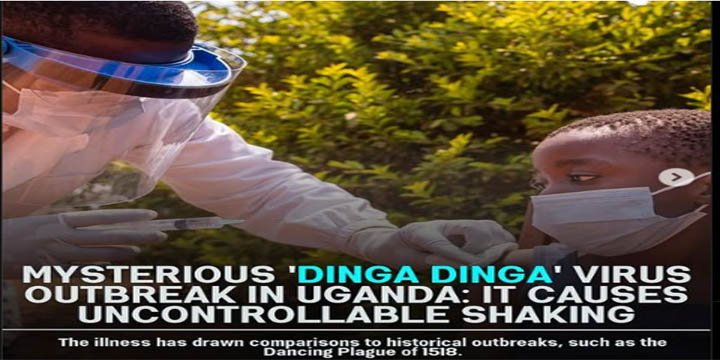DINGA DINGA VIRUS
- A mysterious illness, locally referred to as “Dinga Dinga”, has caused widespread panic in Uganda, primarily affecting women and girls in the Bundibugyo district.
- The disease has left more than 300 people affected, with patients experiencing severe shaking and fever.
- The condition is still under investigation, and scientists are working to understand its causes and potential treatment.
OVERVIEW
- Location: The outbreak has been reported in Bundibugyo District, located in western Uganda.
- Number of Affected: Around 300 people have been affected so far, mostly women and girls.
- Symptoms: The illness is primarily marked by fever and severe body shaking, which impairs mobility and disrupts daily life.
SYMPTOMS
- Fever: A high body temperature is a common early symptom.
- Headache: Patients frequently report strong headaches.
- Cough and Runny Nose: Respiratory symptoms like a persistent cough and runny nose have been observed.
- Body Aches: General body pain and discomfort are prevalent.
- Excessive Shaking: The most distinctive symptom, especially affecting women and girls, is the uncontrollable shaking or tremors. This shaking makes it difficult for those affected to move or carry out normal activities.
CURRENT TREATMENT & RESPONSE
- Antibiotics for Treatment: According to Kiyita Christopher, the district health officer of Bundibugyo, the illness is currently being treated using antibiotics administered by community health teams. No fatalities have been reported so far.
- Kiyita also emphasized that herbal medicine is not effective against the disease, advising affected individuals to seek treatment from health facilities within the district.
- Recovery Time: The disease is generally self-limiting, with most patients recovering within one week of treatment. No deaths have been reported as a result of the illness so far, which is a positive sign for the community.
INVESTIGATION & DIAGNOSTIC CHALLENGES
- Samples Sent for Analysis: Samples of the virus have been submitted to Uganda’s Health Ministry for further analysis.
- However, as of now, no official statement has been released, and the exact cause of the illness remains unclear.
- Comparisons to the “Dancing Plague”: Experts have drawn comparisons between the Dinga Dinga virus outbreak and the Dancing Plague of 1518, a historical event that occurred in Strasbourg, France, where people danced uncontrollably for days.
- In some cases, the dancing continued until the affected individuals collapsed or even died from exhaustion.
- The connection lies in the involuntary, repetitive movements (shaking or dancing) that both outbreaks share.
- Pending Lab Results: Investigations are ongoing to determine if the illness is related to any respiratory pathogens, such as:
- Influenza
- COVID-19
- Malaria
- Measles
- However, the precise pathogen responsible for the condition has not yet been identified, as lab results are still pending.
WHO’S REPORT
- Wider Impact: According to the World Health Organization (WHO), the Panzi Health Zone has reported 394 cases, with 30 fatalities linked to similar symptoms in the region.
- Local Outbreak: Currently, no cases have been reported outside of Bundibugyo district, and it is not clear whether the disease is spreading to other regions of Uganda or neighboring countries.
GOVERNMENT & COMMUNITY RESPONSE
- The Ugandan Ministry of Health has stepped up its efforts to investigate the illness and prevent further spread.
- The government is working closely with health organizations, including the WHO, to gather more data and determine the exact cause.
- Health teams are on the ground, offering treatment, and educating the local population on the importance of seeking medical care at designated health facilities rather than relying on traditional herbal treatments.
PRECAUTIONARY MEASURES
- Seeking Treatment: Authorities urge locals to avoid self-medication and instead seek professional medical care at health facilities across the district.
- Research Efforts: The ongoing research is focusing on identifying the pathogen responsible for the illness and preventing its spread to other regions.
Note: Connect with Vajirao & Reddy Institute to keep yourself updated with latest UPSC Current Affairs in English.
Note: We upload Current Affairs Except Sunday.


